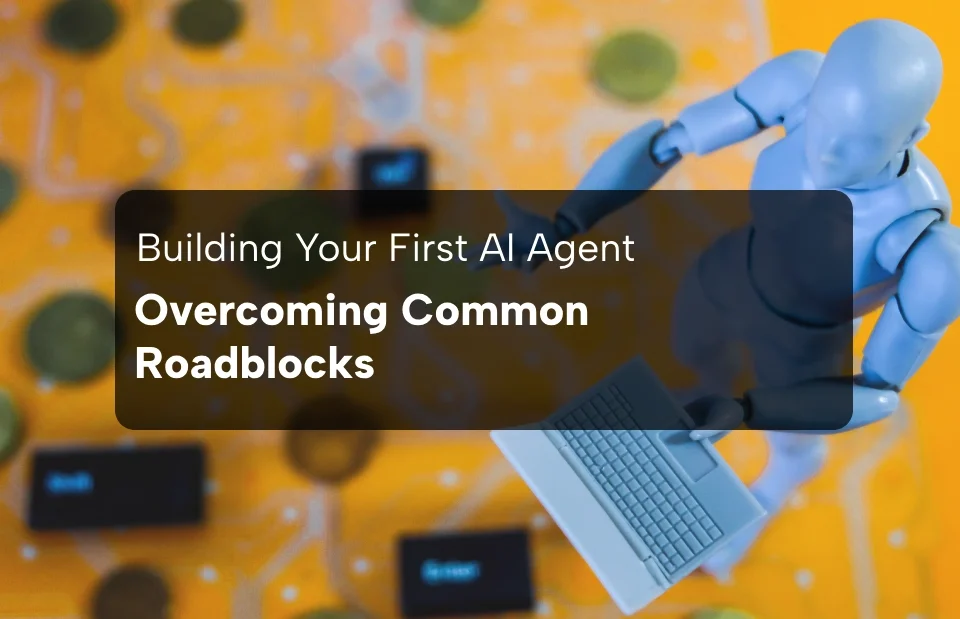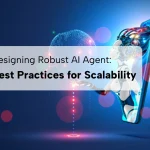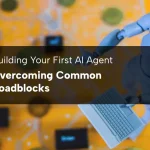Table Of Contents
Introduction
Everyone remembers the moment GenAI went from a buzzword to being a business tool. We saw LLMs generate fluent content, answer complex queries, and stimulate creativity. But the real challenge began when companies tried applying these models to actual business operations.
Soon, they hit the same walls:
- Limited context retention
- Lack of stepwise reasoning
- Hallucinated outputs
- Constant need for human supervision
That is where AI Agents entered the picture. Unlike traditional models, they can plan, reflect, adapt, and act. And when designed right, they can do all this autonomously, at scale, and without burning through teams.

However, none of that is possible without the right AI agent architecture. Architecture is what turns an agent from a demo into a deployable system.
It determines:
- How the agent processes inputs and stores memory
- How does it choose the next best action
- How it collaborates with tools, data sources, and other agents
- How it evolves over time
In this blog, we will walk you through everything you need to know about an ideal AI agent architecture. You will also learn proven practices for designing scalable, intelligent AI agent architectures.
What is AI agent architecture?
AI agent architecture refers to the structural design that governs how an intelligent agent perceives, decides, acts, and learns within its environment. It leverages technologies like ML, deep learning, computer vision, and NLP to evoke intelligent behavior.
Think of it as a blueprint that determines how it works from input to output. All the tasks that an AI agent does, like following an SOP, sending automated emails, scheduling virtual meetings, taking human-like decisions, or updating ERP, are supported by the architecture.
Real-World Use Case: Debt Collection Agent with Full Architecture
A microlending fintech company used AIWorkfllow to build a debt-collection voice agent. The agent didn’t just read from a script. It used:
- Perception to identify the borrower’s tone and urgency
- Memory to access past repayment history
- Planning to choose the best time to follow up
- Execution to send reminders via call and WhatsApp
- Learning to improve follow-up timing based on response rates
The results?
- 62% higher response rate than manual calls
- 38% faster conversions.
- Better repayment rates.
Why Does Architecture Matter in AI Agent Design?
Now that we know what an agent architecture in artificial intelligence is, the next question is: Why does this structure matter so much in practice?
Because without architecture, even the most intelligent architecture agent in AI breaks down under real-world conditions. Vertical AI agents are expected to become the norm by the end of 2025.
Here’s what happens when you skip the architecture –
- No memory = Every interaction feels new.
- No planning = No goal alignment or sequencing.
- No execution layer = Can’t trigger actions, only reply.
- No feedback = Repeats errors, doesn’t improve.
Below are four reasons why logic based agent architecture in AI is non-negotiable:
-
Architecture Handles Complexity That LLMs Alone Can’t
Large language models (LLMs) are great at generating text. 67% of global organizations using it second that. However, they lack structured memory, planning, and execution control. They don’t know when to act, which tool to use, or how to track outcomes.
AI agent architecture gives your system:
- A memory layer to store and retrieve past interactions
- A planning module that sequences multistep tasks
- An execution layer to take real actions via tools/APIs
- A feedback mechanism to check if the task succeeded
Example:
Suppose an AI agent is helping with employee onboarding. The agent needs to schedule meetings, send checklists, answer FAQs, and track completion. Without a proper framework in place, a chatbot can only respond to messages.
But where there is the right architecture, an onboarding assistant can book intro calls, schedule training sessions, update checklists, and track progress. It will also access tools like-
- Slack for communication
- Google Calendar for scheduling
- Notion or Trello for task tracking
-
Architecture Enables Reliable Tool Usage
AI agents often need to call APIs, run code, or interface with enterprise tools. But if the logic to handle those actions is hard-coded into prompts or LLM flows, it’s brittle.
A modular architecture separates reasoning (what needs to be done) from execution (how it’s done). This makes tool usage more:
- Reusable – agents can work across use cases.
- Auditable – you can debug which tool failed and why.
- Safe – you can define tool access policies and logging.
-
Architecture Supports Collaboration Across Agents
Multiagent systems require clear structures for:
- Role delegation
- Communication protocols
- Shared memory or blackboards
Without this, agents step on each other’s tasks or pass incomplete data.
-
It’s the Only Way to Scale
As task volume, user sessions, and tool integrations grow, hardcoded prompts and rules fall apart. Architecture allows:
- Distributed load (using horizontal or hybrid agent models)
- Session context management (memory per user)
- Modular upgrades (swap planners, tools, models as needed)
Without this, adding one new use case means rewriting the whole logic.
Types of Agent Architecture in AI
Architectures vary based on scale, task complexity, and how agents interact (or don’t interact) with each other.
When it comes to the main types of agent architectures in AI, there are two broad categories:
- Single-agent Architectures
- Multi-agent Architectures
- Hybrid Architectures
Let’s break down each one with structure, strengths, limitations, and best-fit scenarios.
-
Single-Agent Architecture
What is a Single Agent Architecture?
One agent operates independently. It processes inputs, makes decisions, and takes actions without relying on others.
When to use:
- For simple, well-scoped tasks
- No collaboration or data sharing is needed
Examples:
- Amazon’s Sequoia system tracks inventory using cameras and live data. It knows where products are, when to restock, and how to move items between warehouses.
Results:
- Order Processing costs down by 25%
- Improved packaging and shipping
-
Marketing management agents work autonomously to do complex marketing campaigns like:
- Adding discounts on orders above $300
- Sending personalized emails to past customers
- Adjusting PPC as per the budget
-
In materials research, Google DeepMind’s system acts as a single, architect agent.
The agent performs the following actions:
- Reads and processes experimental data to find useful chemical patterns,
- Predicts which compounds are worth testing next, and
- Sends those choices to robotic labs for real-world validation
This has resulted in:
- Discovering over 2.2 million new crystalline materials
- Achieving a 71% success rate
-
Multi-Agent Architecture
This approach uses multiple agents that either specialize in tasks or share the load.There are three ways to structure a Multi-agent architecture:
Vertical (Hierarchical) Agent Architecture
Structure:
- One lead agent assigns and oversees subtasks.
- Other agents report back their progress.
Strengths:
- Clear task delegation
- Works well in repeatable, rule-based workflows
Challenges:
- If the lead agent fails, the system stalls.
- Not ideal for open-ended or creative tasks
Horizontal (Peer-to-Peer) Architecture
Structure:
- All agents operate equally
- Each takes responsibility for a part of the task and shares findings
Strengths:
- Faster parallel execution
- Encourages collaboration across different models or capabilities
Challenges:
- Higher coordination needs
- Risk of duplicated or conflicting work
- Slower consensus-building
Example Use Case:
- Cross-domain market research assistant
- GenAI tools using multiple modalities (text + image + structured data)
- RAG-based systems pulling insights from multiple sources
-
Hybrid Architecture
This approach uses multiple agents that either specialize in tasks or share the load.Vertical (Hierarchical) Agent Architecture
Structure:
- Mix of vertical and horizontal
- Leadership or task assignment may shift depending on the phase
Strengths:
- More adaptive to changing environments
- Supports long-running workflows that change over time
- Best suited for real-world, multistep workflows
Challenges:
- Complex to manage
- Requires robust communication protocols
- Harder to debug if something goes wrong mid-process
Example Use Case:
- The AI project manager coordinates a software build with research agents, coding agents, and testing agents, switching control as needed.
- AI-powered customer success platforms coping with various client stages
7 Proven Best Practices for Scalable Agent Architecture
As more companies move toward autonomous systems, scalability becomes non-negotiable. Nearly 92% of companies plan to increase AI adoption by next year. However, with poorly planned architecture, bottlenecks such as failed automation make it difficult for systems to adapt.
Below are some practices to build a scalable AI agent architecture:
-
Break Down Workflows Into Clear, Repeatable Tasks
Instead of assigning broad goals to an agent, map out specific steps it needs to take. Each step should be defined, measurable, and reusable across other workflows.Breaking tasks down helps avoid unnecessary complexity.Example for an onboarding agent:- Step 1: Send a welcome email.
- Step 2: Schedule intro call
- Step 3: Create a user account in CRM
Each task becomes a building block for future automation. -
Match Architecture Type to the Use Case
80% of AI projects fail due to bad architecture selection. Hence, it is important to match the architecture type with your use case.Not all agent architectures are created equal. Your choice should depend on the level of collaboration, control, and reasoning your agents need. -
Build with Modularity in Mind
Make each agent or function independently testable, replaceable, and upgradable. This prevents the entire system from breaking when one piece fails.What this looks like:- Independent vector memory modules
- Plug-and-play connectors for APIs
- Separate prompt chains per agent
-
Prioritize Reusability Across Workflows
Avoid hardcoding agents to one task. Instead, create reusable modules like a summarizer, retriever, or formatter that can be reused across different workflows. -
Implement Chain-of-Thought or Tree-of-Thought Planning
For tasks that require reasoning or multiple decision points, introduce logic flows like CoT or ToT. These guide agents to act sequentially, reflect, and course-correct mid-task.Example: A customer support agent reflecting:- What was the user’s last complaint?
- What did we promise earlier?
- Is escalation required, or can this be handled via automation?
-
Track Performance in Real Time
The market is expected to reach $100 billion by 2032, helping businesses save labor costs and improving productivity. They help by using analytics dashboards to monitor:- Task completion rates
- Errors or failed attempts
- Tool usage patterns
- Agent response times
This helps you spot breakdowns and fix them early. -
Layer Short-Term and Long-Term Memory
Use working memory for session-specific data and persistent memory for context across interactions. Tools like vector databases, embeddings, or document stores help agents remember past behavior and preferences.
Final Thoughts
A powerful AI agent is not just about how well it performs today. And that level of intelligence doesn’t come from adding more computing or stacking more prompts. It comes from a thoughtful architecture of intelligent agent in AI.
Scalable architecture enables agents to remain reliable under load, improve with feedback, and plug in to evolving business needs. Wondering what this architecture could look like for your use case? Let us walk through a demo built around your real workflows.

Dhruv Dholakia has spent over a decade helping enterprises streamline operations through workflow automation and digital transformation. With a strong belief in building purposeful tech, he now focuses on the next frontier—custom AI solutions and Agentic AI. For Dhruv, AI isn’t just a buzzword; it’s a tool to solve real-world problems and create lasting impact. He’s passionate about making AI accessible, responsible, and truly useful for people, teams, and businesses navigating today’s fast-changing world.





